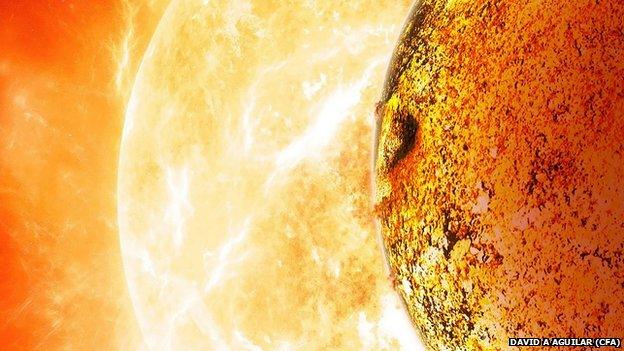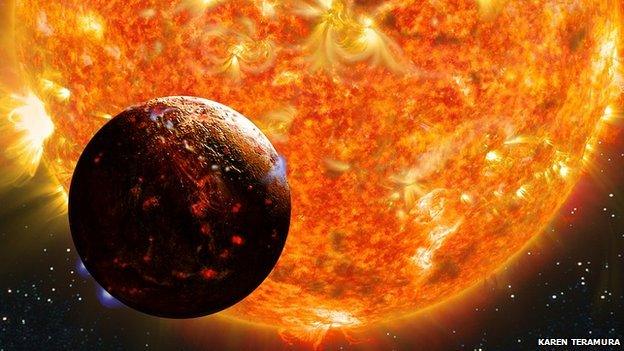Earth-sized 'lava world' discovered
- Published

A doomed "lava world" with a similar mass and density to that of Earth has been discovered orbiting a star 400 light-years away.
Observations suggest the planet, named Kepler 78b, is composed mostly of rock and iron, much like our own planet.
But its extremely close proximity to its host star - a hundredth of the distance between the Earth and the Sun - remains something of a puzzle.
Details of the work by two teams of researchers appear in Nature journal.
From theory, astronomers expect the planet to be tidally locked to its host star, which means that one side is permanently facing in, and the other side permanently facing away.
Temperatures on Kepler 78b's "dayside" - the side of the planet facing its star - are a searing 2,000C-2,800C, far too hot to support life.
"I think it's safe to say that the surface on the 'dayside' is molten," Josh Winn, associate professor of physics at the Massachusetts Institute of Technology (MIT), told BBC News.
But he added: "Nobody has really calculated whether or not we expect the 'nightside' to be molten (we do not know the temperature of the nightside), nor how far down the molten layer is expected to go within the planet."
The hot Earth-twin belongs to a new class of "ultrashort period" planets recently identified by the now-defunct Kepler space telescope. These newfound worlds all complete one circuit of their host star in less than 12 hours.
But according to current theories of planet formation, Kepler 78b could not have formed so close to its star, nor could it have moved there.

One of the teams made observations with the Keck Observatory on Hawaii
Dimitar Sasselov, from the Harvard-Smithsonian Center for Astrophysics, an author on one of the Nature papers, said: "Kepler 78b is going to end up in the star very soon, astronomically speaking.
"It couldn't have formed in place because you can't form a planet inside a star. It couldn't have formed further out and migrated inward, because it would have migrated all the way into the star. This planet is an enigma."
Kepler 78b's orbit and size have been determined by analysing the light given off by the star as the planet transits, or passes in front as viewed from Earth.
The researchers detected a transit each time the star's light dipped, and measured this dimming to determine the planet's size. This was possible because the bigger an exoplanet is, the more light it blocks.
But measuring the planet's mass involved tracking the motion of the star itself. Depending on its mass, a planet can exert a gravitational tug on its star. This stellar motion can be detected as a very slight wobble, known as a Doppler shift.
The results suggest Kepler 78b is about 1.2 times the size of Earth, and 1.7 times as massive. From the same measurements, the astronomers calculated the planet's density as 5.3 grams per cubic centimetre, close to the 5.5 grams per cubic centimetre value for Earth.
These results provide strong evidence for Kepler 78b's rocky composition.
Dr Winn said the fact that two independent teams of scientists came to similar conclusions about the alien world added confidence to the measurement.
Kepler-78b is probably a doomed world, researchers explained. Gravitational tides are expected to draw it ever closer to its star.
Eventually it will move so close that the star's gravity will rip the planet apart, vanishing within three billion years.
Paul.Rincon-INTERNET@bbc.co.uk and follow me on Twitter, external

- Published24 October 2013
- Published22 October 2013
- Published16 August 2013